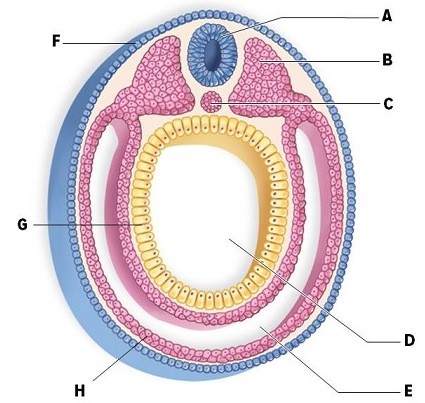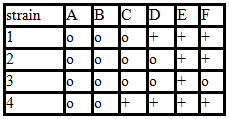Identify and briefly describe the labeled structures in the cross section of the vertebrate embryo.
What will be an ideal response?
A. neural tube: The neural tube is formed by closure of the neural groove. In vertebrates, it develops into the brain and spinal cord.
B. somite: A somite is a mass of mesoderm lateral to the notochord in vertebrates. Somites give rise to muscle.
C. notochord: A cartilaginous supportive dorsal rod found at some time in the life of all chordates. In vertebrates, it is replaced by vertebrae.
D. gut: A primitive gut is formed by the endoderm as the body folds into a tube.
E. coelom: The coelom is a body cavity completely lined with mesoderm, lying between the digestive tract and body wall.
F. ectoderm: The ectoderm gives rise to the nervous system, the epidermis, and derivatives of the epidermis.
G. endoderm: The endoderm gives rise to the lining of the digestive tract and respiratory tract and the glands associated with these systems.
H. mesoderm: The mesoderm gives rise to musculoskeletal system, cardiovascular system, urinary tract system, lymphatic system, and reproductive system.
You might also like to view...
Which biochemical pathway fits the data presented?
Assume that a series of compounds has been discovered in Neurospora. Compounds A–F appear to be intermediates in a biochemical pathway. Conversion of one intermediate to the next is controlled by enzymes that are encoded by genes. Several mutations in these genes have been identified and Neurospora strains 1–4 each contain a single mutation. Strains 1-4 are grown on minimal media supplemented with one of the compounds A-F. The ability of each strain to grow when supplemented with different compounds is shown in the table (+ = growth; o = no growth).
media supplement

A) A ? B ? C ? D ? E ? F
B) A ? B ? C ? F ? D ? E
C) F ? B ? C ? D ? A ? E
D) A ? B ? C ? D ? F ? E
E) A ? B ? F ? E ? C ? D
Which of the following areas is NOT characterized
by chaparral vegetation? a. California coast b. central Chile c. Cuba d. southern tip of Africa e. land near the Mediterranean Sea
Selective breeding results from programs designed to modify traits in domesticated species.
Answer the following statement true (T) or false (F)
For natural selection to result in evolutionary change _____________.
a. variation must exist in a population b. reproductive success of different phenotypes must differ c. variation must be inherited from one generation to the next d. all of the choices are correct